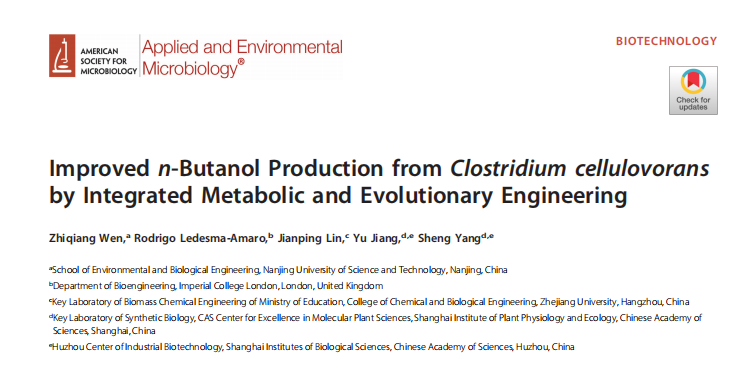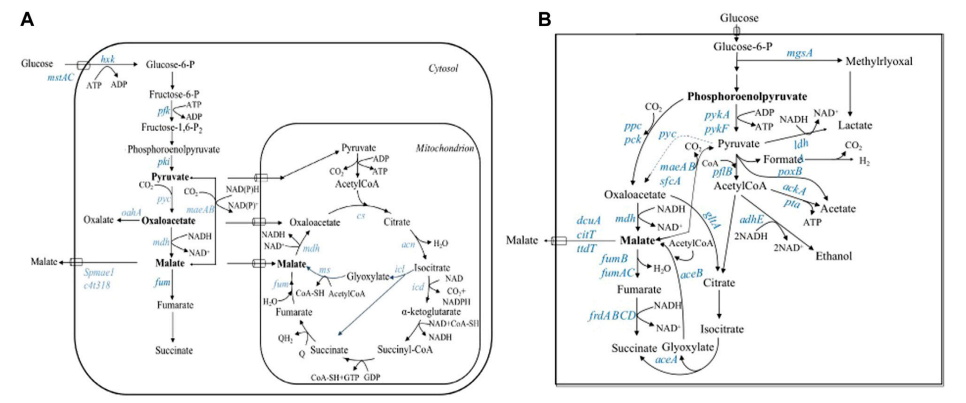
As is well known, microorganisms can produce abundant secondary metabolites and are an important source for drug development. Streptomyces is a star species in the development and research of microbial drugs, and many medical or agricultural antibiotics such as rapamycin (immunosuppressive agent), nystatin (antifungal), avermectin (insecticidal), and azamycin (antibacterial) are produced from Streptomyces. However, the reasons why Streptomyces encodes these active secondary metabolites and the ecological roles they play in their environment have not been understood. Under laboratory conditions, many microbial biosynthetic gene clusters are in a silent state and require specific cultivation conditions to be activated, prompting researchers to speculate that the production of certain antibiotics or toxins by microorganisms is in response to signals from community members in the surrounding environment. Recently, a research team from Germany has for the first time elucidated the ecological role of natural products derived from streptomyces, providing new theoretical basis for the chemical ecological significance of microbial natural products.
The bld system (bldA, bldD, and bldH) of Streptomyces is a regulatory element involved in the development of its mycelium and the biosynthesis of secondary metabolites. Knockout of each bld gene alone can cause Streptomyces iranensis to no longer produce spores and exhibit a bald phenotype (Figure 1a). When co cultured with gene knockout mutant strains, Aspergillus niger no longer produces oxalic acid (Figure 1b), indicating that the BLD system can control the expression of oxalic acid gene clusters in Aspergillus niger. Combining proteomics and transcriptomics methods to identify bldA knockout mutant strains( Δ BLdA analysis revealed that the transcription levels of many genes on the genome were significantly downregulated compared to wild-type strains (WT), including the biosynthetic genes of azamycin (arginine derived polyketide). LC-MS analysis showed that the mutant strain Δ BLdA no longer produces azamycin, confirming that the biosynthesis of azamycin is regulated by BLdA (Figure 1c). To further visualize the spatial distribution of azamycin in co culture environments, researchers analyzed it using matrix assisted laser desorption ionization imaging mass spectrometry (MALDI-IMS), and the results showed that azamycin (components F3a and F4a) was only produced in the area where Streptomyces evansi and Aspergillus nest came into contact (Figure 1d). After 10 days of co cultivation, enrichment of azamycin can be detected on fungal mycelium, indicating a certain affinity between azamycin and fungal mycelium.
To further verify that azamycin produced by Streptomyces is a signaling molecule that induces the production of tryptophan and its derivatives by Aspergillus niger, researchers identified azamycin biosynthesis gene deficient mutant strains( Δ AzlH Δ Azl4 and Δ Azl5) was co cultured with Aspergillus niger, and the results showed that the mutant strains could not induce the production of tryptophan by Aspergillus niger, while the control (co culture with WT and the addition of azamycin to the culture medium) could produce (Figure 1e, f). In addition, linear arginine derived polyketones such as desertomycin A and monazomycin can also induce the production of tyrosine by Aspergillus niger (Figure 1f). The same results were observed in co cultivation of other Streptomyces species (such as S. macroensis and S. mashuensis) with Aspergillus nidulans, indicating that arginine derived polyketide compounds derived from Streptomyces can specifically induce the expression of fungal moss biosynthesis gene clusters (ors BGC).

Figure 1 Identification of arginine derived polyketones from Streptomyces as signaling molecules for inducing the production of tyrosine and its derivatives by Aspergillus niger
To understand the distribution of arginine derived polyketide producing bacteria in soil environment, researchers constructed a rapid screening system for Aspergillus niger green fluorescent protein reporter strain (GFPs orsA) (Figure 2a). 305 potential actinomycetes were isolated and cultured from a 600mg soil sample, and co cultured with the reported strain (A. nidulans or sAp nluc GFPs). It was found that 8 actinomycetes triggered fungi and produced fluorescence (Figure 2a, b). Due to the distant genetic relationship between strain 45 and the other 7 strains (Figure 3a), strains 45 and 219 were selected as representatives for subsequent genome sequencing and bioinformatics analysis, as well as LC-MS detection of fermentation products. The results showed that strain 45 can produce linear mycin, while strain 219 produces Lydicamycin. The metabolic products of both strains are linear arginine derived polyketone compounds. By adding linear arginine or lydicamycin to the fermentation medium of Aspergillus niger, it was confirmed that both can induce the expression of tyrosine gene clusters (Figure 2c), indicating that in addition to cyclic arginine derived polyketones such as azamycin (induction concentration of 10 ng mL-1), linear arginine derived polyketones can also induce the synthesis of fungal natural products, and the strains producing these polyketone compounds are widely distributed (Figure 3b). In addition, adding the supernatant of the leachate collected from soil samples to the reported strain culture medium can also induce Aspergillus niger to produce green fluorescence, indicating that Streptomyces can indeed secrete arginine derived polyketone compounds into the soil.

Figure 2 Isolation and characterization of soil bacteria that produce arginine derived polyketones and induce the expression of the moss tryptophan gene cluster in Aspergillus niger

Figure 3 Phylogenetic tree analysis and geographical distribution of arginine derived polyketide producing bacteria
The human pathogenic fungus, Aspergillus fumigatus, is a fungus with a distant genetic relationship from Aspergillus niger. Co cultivation showed that azamycin can also specifically induce Aspergillus fumigatus to produce fumicycles and fumigermin. To analyze the frequency of fungal specific response to arginine derived polyketones in soil environment, researchers isolated 106 fungal strains (Figure 4a) from the same soil sample (isolated actinomycetes) and compared them with Streptomyces evansi (WT) and mutant strains, respectively Δ AzlH co culture revealed that 31 strains of bacteria, when co cultured with WT, turned red in the fermentation broth, corresponding to Δ The co culture of azlH showed no change. Structural identification confirmed that the red compound produced by 31 fungal strains is Carviolin. Further fungal ITS sequencing analysis identified all Penicillium fungi, indicating that there are a large number of fungi in the soil microbial community that can respond to arginine derived polyketone signaling molecules produced by Streptomyces.

Figure 4 Isolation of Penicillium strain 27 and characterization of its red pigment carviolin induced by azamycin F
Previous studies have shown that arginine derived polyketide signaling molecules can promote the formation of colony morphology with biofilm phenotype in Bacillus subtilis, leading to the formation of multicellular aggregation in green algae (Chlamydomonas reinhardtii). The production bacteria of arginine derived polyketones and fungi that respond to these signaling molecules are widely distributed in the soil environment. At the same time, signal transmission and response events between Streptomyces and fungi are very frequent in the soil microbial community, indicating that this cross species interaction may also lead to changes in the structure and function of the microbial community in its surrounding environment (Figure 5).

Figure 5 Schematic diagram of the signal transduction process of arginine derived polyketide induced fungal production of natural products and its impact on the diversity of microbial community structure
In summary, this study has confirmed through systematic exploration and analysis that cyclic or linear arginine derived polyketones derived from Streptomyces can specifically activate the expression of silenced gene clusters in fungi such as Aspergillus and Penicillium. The producing bacteria of arginine derived polyketones and their interacting fungi are widely distributed in the soil microbial community, and the frequency of this signal transduction and response event is relatively high, It may lead to changes in the structure and function of microbial communities in its surrounding environment, thereby elucidating the chemical ecological significance of Streptomyces producing arginine derived polyketide compounds in soil environment.
The corresponding author of this article is Professor Axel A. Brakhage from the Leibniz Institute of Natural Products and Infection Biology, mainly engaged in research on human pathogenic fungal infection biology, microbial signal transduction, and natural product synthesis biotechnology.
Article information: Mario K. C. Krespach †, Maria C. Stroe †, Tina Netzker, Maira Rosin, Lukas M. Zehner, Anna J. Komor, Johanna M. Beilmann, Thomas Kr ü ger, Kirstin Scherlach, Olaf Kniemeyer, Volker Schroeckh, Christian Hertweck, and Axel A. Brakhage * Streptomyces polyketides mediate bacterial pungi interactions across soil environments Nat Microbiol two thousand and twenty-three
Related recommendations
Strain Engineering for Arginine
Strain Development Service
DNA Synthesis and Assembly
Genetic Engineering and Gene Editing









